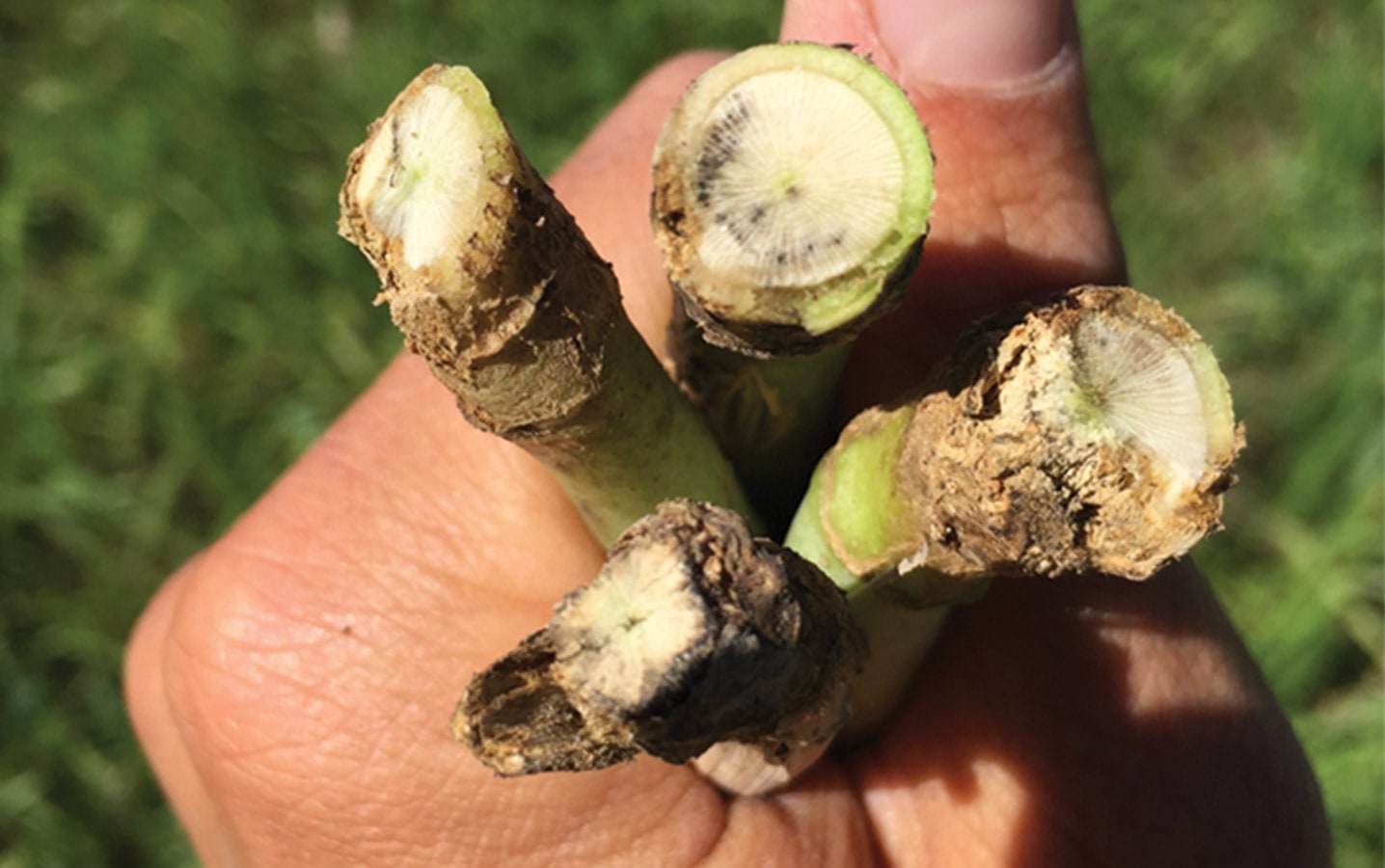Blackleg and Sclerotinia Management Tools for the Prairies
SaskCanola along with Alberta Canola and the Government of Canada through the Growing Forward 2 AgriInnovation Program, have invested in alleviating the threat of blackleg and sclerotinia stem rot for canola farmers and advancing the development of new solutions. These challenging diseases are important concerns as they represent yield loss, economic impacts and potential trade issues. This research has helped pave the way for new tools and technology, advancements in disease-gene screening and new sources of disease-resistance genetics. Farmers benefit directly from the research by being able to understand and manage these diseases in their own fields, and maximizing productivity through access to new and improved disease-resistant canola cultivars.
Advancements in Finding New Sources of Resistance Genes For Blackleg
Current projects focused on new sources of resistance are making progress towards providing new resources and information for canola breeding programs to help improve blackleg resistance options for growers.
Improving canola resistance against blackleg disease through incorporation of novel resistance genes sourced from B. napus, B. rapa and B. oleracea
Principal investigator:
M. Hossein Borhan, AAFC Saskatoon
Purpose:
To identify new major-resistance genes for blackleg disease through the phenotypic screening of 500 accessions of Brassica napus, B. rapa and B. oleracea with many different strains of Leptosphaeria maculans.
Progress:
New sources of resistance genes are needed to protect the commercial canola cultivars against constantly evolving blackleg pathogen populations. After screening over 1,100 B. napus and B. rapa accessions from the Plant Gene Resources of Canada (PGRC), researchers have generated the genetic profile of known resistance (R) genes against blackleg. Through a vigorous screening process including testing against up to an additional 40 isolates,
researchers identified two B. napus lines and several B. rapa lines with potential novel R genes. Preliminary mapping supports the presence of a broad-spectrum novel R gene in one of the two B. napus accessions. This gene, located on the chromosome A1, behaves as a broad spectrum R gene as it shows resistance response to the majority of isolates being tested and will be highly valuable in controlling blackleg disease in Western Canada.
Identifying novel resistance genes from canola relatives and developing canola germplasm with multiple resistance genes sourced from B. nigra, B. juncea, and B. carinata
Principal investigators:
Genyi Li and Dilantha Fernando, University of Manitoba
Purpose:
To use cloned blackleg-resistance genes (1) to identify the effective resistance genes, (2) to monitor the changing of pathogen isolates in canola fields, (3) to guide pyramiding effective resistance genes in the development of canola cultivars, (4) to guide the deployment of canola cultivars with various blackleg-resistance genes; and (5) to identify novel blackleg-resistance genes in canola-relative species.
Progress:
Three years of testing under field conditions have resulted in good progress on the blackleg resistance. Testing results so far have shown that the previously identified horizontal R gene conferred good resistance to all field fungal isolates and performed well under severe blackleg disease pressure in the field. The results suggest that this resistance has excellent potential for blackleg management in Western Canada. Researchers are also making progress towards understanding the role and function of pathogenicity genes involved in disease using molecular tools such as ATMT and CRISPR. Currently, 80 isolates are undergoing phenotype characterization in terms of growth, sporulation, germination, attachment and pathogenicity, and new transformations are ongoing to generate a larger pool of isolates. This will determine the overall function of the gene products and the potential regulatory mechanism involved in L. maculans pathogenicity. All resistance gene-specific molecular markers and their effectiveness information will be provided to Canadian canola seed companies on a non-exclusive basis so they will be able to pyramid several resistance genes in newly released canola cultivars. This will ensure improved blackleg management options for Canadian canola producers.
Genome-wide association mapping of quantitative resistance against blackleg in Brassica napus
Principal investigator:
M. Hossein Borhan, AAFC Saskatoon
Purpose:
(1) To identify tightly-associated genetic markers for controlling adult plant resistance to blackleg; and (2) to define the underlying genetic architecture of this durable resistance to blackleg in B. napus.
Progress:
Researchers have screened and tested several Brassica accessions for adult plant resistance (APR) against blackleg disease primarily at the blackleg field nurseries. A growth chamber based assay was developed that allows the test to be conducted under a controlled environment in a shorter time frame of two to three months compared to nearly six months in western Canadian conditions. Through an intensive screening process and pathology testing, the profile of APR against blackleg disease has been determined for 200 spring type B. napus accessions and the presence of quantitative resistance in 58 lines confirmed. These 58 lines, along with equal number of susceptible lines, have formed the association mapping population. As the next step, the position of the APR genes will be determined and markers linked to APR genes will be developed. Phenotyping and genotyping of individual lines of this population is in progress. B. napus lines with APR and molecular markers will serve as resources for breeding quantitative resistance, which is race non-specific and therefore more durable against the evolving pathogen races.
Transcriptomic analysis of the Leptosphaeria maculans (blackleg-canola) interaction to identify resistance genes in canola and avirulence factors in L. maculans
Principal investigator:
Richard Bélanger, Laval University
Purpose:
(1) To identify effectors and evaluate the comparative transcriptomic response of susceptible and resistant canola lines to virulent isolates of Leptosphaeria maculans (blackleg); and (2) to identify specific resistant genes in canola involved in the expression of an incompatible interaction with L. maculans.
Progress:
Researchers performed a transcriptomic analysis of resistant and susceptible B. napus genotypes infected with L. maculans to investigate the defense responses and provide a basis to understand molecular mechanism involved in blackleg disease development in canola. The transcriptome sequence for canola and L. maculans has been completed. (The transcriptome is a measure of the expression of all genes in a cell or tissues of any given organism under a particular condition.) Comparisons between the compatible and incompatible interactions led to the identification of 28 effector proteins suggesting a role in the establishment and maintenance of biotrophy. These included all known avirulence (Avr) genes along with eight newly characterized effectors. Another 15 effector proteins were exclusively expressed during the necrotrophic phase of the fungus, which supports the concept that L. maculans has a separate and distinct arsenal contributing to each phase. Researchers are also evaluating the potential role of aquaporins (AQPs) during biotic stress conditions in resistant and susceptible genotypes, including the induction of disease immunity pathways. Aquaporins are pore-forming proteins that facilitate transport of water and many other small molecules like urea, silicon, boron, hydrogen peroxide and even carbon dioxide, in and out of the cell. Genome-wide identification performed in seven Brassicaceae species revealed a total of 380 AQPs. The identification, classification, evolution and functional regulation of AQPs performed in the present study will be helpful for enhancing the understanding of AQPs and for the development of more sustainable stress-tolerant crops.
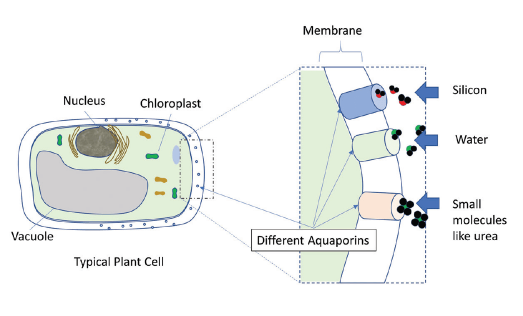
Monitoring Blackleg Pathogens and Progress on Resistance Labelling
Research projects are focused on understanding and monitoring pathogen races and populations across the Prairie provinces in farmers’ fields. In addition, they have led to the development of a new blackleg R-gene labeling system which will provide growers with another tool to manage blackleg on their farms.
Durable blackleg resistance stewardship through knowledge of blackleg pathogen population, resistance genes and crop sequence towards the development of a cultivar rotation program in the Prairie Provinces
Principal investigator:
Dilantha Fernando, University of Manitoba
Purpose:
To analyze avirulence (Avr) gene diversity and frequency of different Avr genes in different farms.
Progress:
Researchers continue making progress with additional findings to support the R-gene management strategy for blackleg. The project is collecting information from 50 representative grower sites across Alberta, Saskatchewan, and Manitoba from fields that have had blackleg to various degrees. In 2016, profiling Avr in L. maculans isolates collected from these fields generally found high frequency of AvrLm4, AvrLm7 and AvrLm6 in the pathogen population, while AvrLm2 was more variable than in other years. In contrast, AvrLm1, AvrLm3 and AvrLm9 were generally absent in the fields monitored in 2016, indicating that the R-genes Rlm1 and Rlm3 found in these canola varieties are no longer effective in certain areas. These differences in blackleg disease among fields may be due to non-specific resistance in these canola cultivars, crop rotation practices and weather conditions at these locations. Researchers also developed a new protocol to quantitatively assess the colonization of canola tissue
by the blackleg fungus, which may be used to rapidly determine non-
specific resistance. The research information on the R-genes found in major commercial canola varieties and the Avr profile in the current pathogen population will provide growers and industry with additional tools for improved blackleg management. This work also supports the new initiative to label major R-genes for canola cultivars, helping growers to more effectively manage blackleg on their farms.
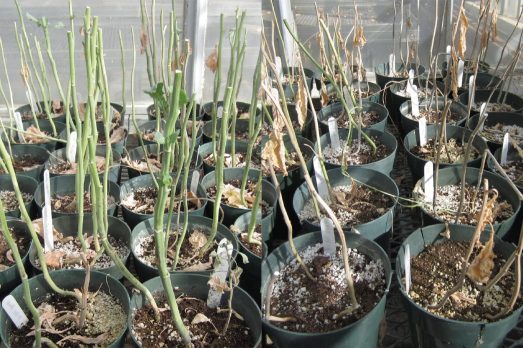
Investigating the Resistance (R-gene) durability of canola cultivars and emergence of virulent blackleg isolates in farmers’ fields
Principal investigator:
Dilantha Fernando, University of Manitoba
Purpose:
(1) To assess which cultivar resistance genes are most durable to disease pressure and make recommendations on when and how often to rotate cultivars studied; and (2) to examine the potential of emergence of virulent isolates when a new cultivar without corresponding resistance is introduced.
Progress:
Researchers are continuing to make progress on a method to assess the durability of any new blackleg R-genes or stacked R-gene combinations that may be made available to growers. The study is based on using the common canola-wheat two-year rotation. For the first study objective, plots of isogenic lines (ILs) carrying different single resistance genes (R-gene) were established and inoculated with 10-per-cent-virulent isolates to the corresponding R-gene. In subsequent years, the proportion of virulent isolates was measured. For the second objective, ILs carrying different R-genes were seeded and inoculated with 100-per-cent-avirulence (Avr) isolates to the corresponding R-gene. A patch of a susceptible line is used to maintain disease pressure. The plots are monitored to record if and when virulent isolates emerge, the number of generations required to produce virulent offspring, and to compare results between the different R-gene lines. At the end of the four-year project, the results will provide benefits to both growers and breeders. For growers this will result in recommendations of when to use different blackleg-resistant varieties based on their R-gene durability and the nature of emergence of new races.
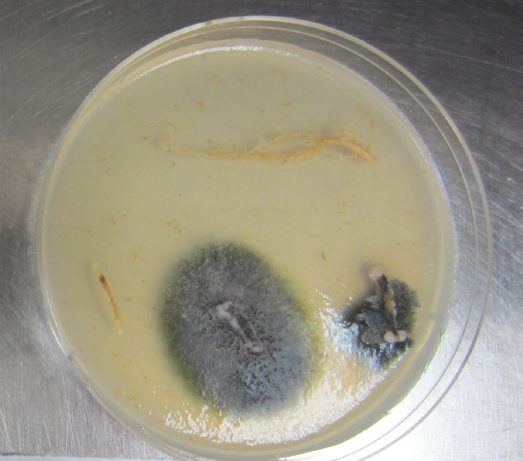
New Technology and Tools for Blackleg Management in the Field
Researchers are making significant advancements in the development of tools, guidelines, and recommendations to help industry and farmers understand and manage blackleg disease in their canola rotations. A new blackleg yield-loss model helps farmers and industry quantify the economic impact of this serious disease.
Rapid field diagnostics of the blackleg pathogen races through the identification of pathogen avirulence (Avr) genes and the development of Avr-specific markers
Principal investigator:
M. Hossein Borhan, AAFC Saskatoon
Purpose:
To develop molecular markers as an efficient tool for genotyping and monitoring L. maculans populations in canola fields across Western Canada.
Progress:
Researchers have established a database of L. maculans genome sequences and developed PCR-based KASP markers. These markers have been extensively tested against close to 200 L. maculans isolates collected from canola fields across Western Canada. The markers have proven to be a highly accurate, high-throughput and cost-effective tool for determining the blackleg profile in farmers’ fields. These KASP markers and protocol have been shared with the industry and a test has been planned in co-ordination with SaskCanola and the Canola Council of Canada to make this tool available to canola farmers by helping diagnostic labs adopt the methodology. By knowing the genotype of blackleg isolates, farmers will be able to choose the right canola varieties with resistance gene(s) against isolates present in their field. This will be a significant contribution to blackleg management for farmers.
Development of a blackleg yield-loss model and assessment of fungicide resistance in western Canadian populations of Leptosphaeria maculans
Principal investigator:
Stephen Strelkov, University of Alberta
Purpose:
(1) To develop a yield-loss model to relate the severity of blackleg on canola with the corresponding yield losses; and (2) to evaluate representative populations of L. maculans from western Canada for the occurrence of fungicide resistance.
Progress:
This study is complete. Please read the
summary here: First yield-loss model for blackleg on the Prairies.
Advancing Sclerotinia Resistance in Canola
Researchers have made significant advancements towards developing canola cultivars with true sclerotinia resistance a reality in the near future. Progress and development of new protocols, genome sequencing and screening are helping industry and farmers improve management of this disease in canola.
Characterization of defense genes underlying quantitative resistance loci (QRL) to Sclerotinia stem rot in Asian Brassica napus and transfer of resistance to Canadian spring-type canola
Principal investigator:
Lone Buchwaldt, AAFC Saskatoon
Purpose:
(1) To identify molecular markers linked to sclerotinia resistance and identification of underlying defense genes; and (2) to transfer sclerotinia resistance to elite open-pollinated spring-type canola.
Progress:
Although sclerotinia resistance is a very rare trait, researchers have been able to generate B. napus lines with high levels of sclerotinia resistance. Canola breeders are interested in developing new canola varieties with sclerotinia resistance and some have requested seed of the resistant lines, molecular markers linked to the resistant trait, and sclerotinia isolates for screening of breeding lines. These lines will enable plant breeders to develop canola varieties with a high level of sclerotinia resistance, which will reduce the need for fungicide application, resulting in economic benefit to growers and also safeguarding growers, consumers and the environment. Researchers have also developed a stem-test protocol for testing canola for resistance to S. sclerotiorum. In 2016, after five years of evaluation by nine collaborators, the protocol was approved by the Western Canada Canola/Rapeseed Recommending Committee (WCC/RRC) as a standard for assessing sclerotinia resistance of lines submitted to co-op tests. Canola breeders and an increasing number of scientists in other countries including Australia and India are also using this stem test protocol. By the end of the project, researchers expect that the first canola lines with improved sclerotinia resistance from the program will be available for licensing. This resistance is expected to be long lasting, since it relies on several defense genes that are not easily overcome by changes in the pathogen population.
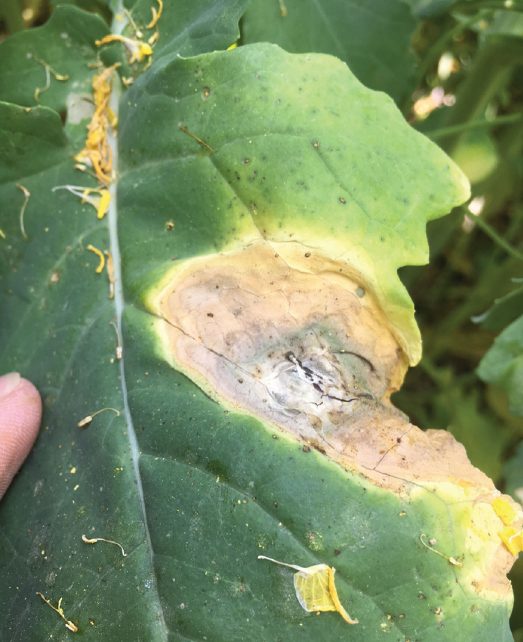
Resistance to Sclerotinia sclerotiorum necrosis-inducing proteins in canola
Principal investigator:
Dwayne Hegedus, AAFC Saskatoon
Purpose:
(1) To identify proteins secreted by S. sclerotiorum that cause or contribute to necrosis; and (2) to develop a method to screen B. napus lines for resistance to their effects.
Progress:
In this project, several new S. sclerotiorum proteins, which cause the necrotic lesions associated with stem rot disease, were discovered. The proteins are now under study and tools are being developed to screen collections of B. napus lines for resistance to their effects. This project has greatly improved the understanding of S. sclerotiorum disease as the researchers catalogued for the first time the entire suite of genes deployed during each stage of the infection on canola. This project also contributed to an international consortium of Australian, U.S., European and Canadian researchers to sequence the S. sclerotiorum genome, which was published and deposited in a public database. A new international consortium is now comparing the genomes of S. sclerotiorum isolates from around the world to provide information on virulence and crop specificity. SaskCanola’s investment in this project has been greatly amplified as it permitted participation in these international initiatives and is leveraging access to information, plant collections and tools that will ultimately lead to the development of new stem rot-resistant varieties for Canadian producers.
Results for these 12 projects will be posted on the SaskCanola website saskcanola.com as they come in. Some of the results will be featured this year at CanolaWeek, December 5-7 in Saskatoon. SaskCanola’s website will have registration details. All final reports are likely due end of April 2018.





